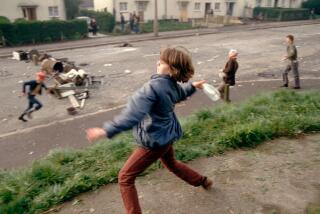Book Review : Portrait of a Hardy Irish Subculture
Puck of the Droms: The Lives and Literature of the Irish Tinkers by Artelia Court; with folk tales, other oral literature, and biography collected by Alen MacWeeney with the collaboration of Artelia Court; literary notes by Thomas Munnelly and others; photographs by Alen MacWeeney (University of California: $24.95)
Throughout recorded Irish history, a fascinating (though by no means unique) aspect of its traditional social structures has been the reliance on socially marginal and mobile populations and “types” for economic, ideological and aesthetic reinforcement.
From the early Christian tuath , or tribal kingdom, to the modern city, the roaming outsider freed of conventional restrictions on activity and identity--variously assigned the role of poet, priest, scholar, artisan, artist, mercenary or wild man--has provided an offbeat counterpoint for the testing of the social fabric and, consequently, has been invested with the aura of the sacred.
Though despised for their shabbiness and feared for the dangerous alternatives they pose, such outsiders have been respected, relied upon and heeded as the refracting mirrors of society--strange familiars better informed about tradition than society itself.
In the book “Puck of the Droms,” Artelia Court presents an informative introduction to the tinkers of Ireland, the itinerant population that constitutes Ireland’s own variety of gypsy. Her essay and the tinkers’ oral accounts of their lives and lore--collected by Alen MacWeeney and the author in the late ‘60s--delineate the place of the tinker in this long-lived Irish conceit of the outsider as bearer and reminder of traditional culture and its philosophical ramifications.
“In the 1950s and 1960s,” she writes, “while the rest of the citizenry strove to shed its local peculiarities . . . by industrial, financial, and educational development to prepare itself for membership in the ‘global village,’ the Tinkers still pursued the idiosyncratic, mobile style of life that had been an indispensable--although in ways a proscribed--element of traditional Irish society.
“Tinkerism embodied many of the dynamics and devices of benighted but ancient Irishness and, in some instances, Europeanness, and its contemplation yields a glimpse of the buds that blossomed into several of the most seductive and thorny concepts of the present day: racism, professionalism, commercialism, mass communications and the species of individualism that compensates for and yet serves the power of the impersonal state.”
The plethora of “-isms” enumerated in the above quotation notwithstanding, the tinkers emerge as distinctive and very human characters, whose shadowy emergence in early modern Irish history and quirky life style (marked by an odd blend of flexibility and inflexibility) are ably sketched out in Court’s eloquently expressed and sympathetically analytic study.
Tinkers and Their World
Following her introduction, three tinkers, bound in spirit to the Traveling Life even when converted to the “settled life,” speak at length for themselves about themselves and their world. Their oral autobiographies make up the heart as well as the bulk of the book.
We hear the voices of Bridget Murphy, Wicklow hawker and housewife, whose grandfather married a tinker woman and took up traveling ways; Patrick Stokes, traveling tinsmith from the west of Ireland turned Dublin vagrant, who laments the passing of the era when his craft still was needed; and Johnny Cassidy, Wexford tinker patriarch and virtuosic storyteller, whose fine tales, he proudly states, carry on the tradition of seven generations (“they was true on time”).
Pervading these private histories is an acute sense of self evolving in the mold of tradition, as well as a melancholic awareness of the responsibilities that go with social destiny. In Stokes’s words: “My life story now, it’s just very hard to think of it. If you have the name of being an early riser you can sleep forever. I often told a man the truth and he wouldn’t believe me, and I often told a man a lie and he believed me. . . . So, I’m a liar, I’m a rogue, and I’m a thief. I’m one of each. . . . Some of them calls us Travelers, Gypsies, or mumpers. Maybe itinerants, tramps, or wasters. I heard them say no-goods, scoundrels, and nackers . But I’d say we’re minkers , puck o’ the droms (i.e., ‘trickster of the roads’).”
The ambivalence of the tinker musing on his life is matched by the complex attitude of the settled folk toward the tinker--who, in the pre-plastic era, provided them with tinware, regaled them with story and song, bought and sold their horses, trespassed, poached, begged and enjoyed a variety of subtly reciprocal relationships with them.
Bridget Murphy describes the social milieu of her childhood: “The people always respected us because they knew, like, that even though we were very, very poor, me mother and father seen that we were honestly reared. . . . And the people were so good to us; when they’d kill pigs or anything in the district I think we got the best part of it. It was through the people that really we were reared, you know what I mean. Only for them we’d have never got on.”
Traditional Songs
Strategically placed among the accounts of personal experiences, and enriching them considerably, are traditional songs (words only) and stories collected from various tinker informants by MacWeeney and Court. The extensive and valuable notes on these texts are mostly written by Tom Munnelly and Daithi O hOgain, two distinguished specialists in Irish folklore.
One could object to Court’s insistent characterization of orally transmitted tales and songs as “literature,” and it is surprising that there is no mention made anywhere in the book of the considerable corpus of published research on the tinkers done in recent times by George and Sharon Gmelch.
These flaws aside, “Puck of the Droms” is a very scholarly and readable portrait of a remarkably hardy Irish subculture.
More to Read
Sign up for our Book Club newsletter
Get the latest news, events and more from the Los Angeles Times Book Club, and help us get L.A. reading and talking.
You may occasionally receive promotional content from the Los Angeles Times.







